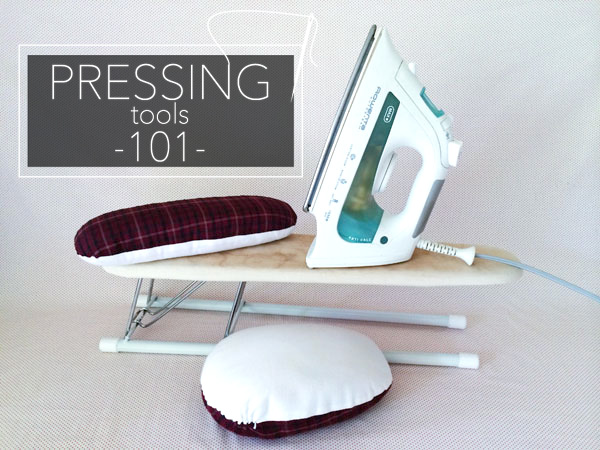Every garment sewer should have a small army of pressing tools on hand to help make each step along the way easier. Learn about my favorites, from the most basic to more specialty, and then stock your sewing room with those that fit your sewing needs!
Here are my top 6 pressing tools for sewing beautiful, better-than-ready-to-wear garments!

1. Iron
Okay, so saying that you need an iron is so obvious, but you would be surprised how many new sewers I teach that do not have an iron. Many students ask me if having a steamer is okay, and my answer is always yes! Having a steamer is great, but it will not take the place of an iron, as they do totally different jobs.
When looking for a new iron, I suggest that you find one that has high settings for steaming, so if you want to hover and steam something, this can be done. Also, not all irons can steam when held upright and can only steam when held parallel with the ground, so check for that setting as well. I also suggest for safety purposes that you find one that has an automatic off setting, so it does not waste energy or potentially something worse.
2. Ironing board
Again, this seems really obvious, but hand-in-hand with the “do I really need an iron” question is the “do I really need an ironing board” query. I think that a full-sized ironing board is best, but I do understand that some urban dwellers simply do not have enough space for this. If you really do not have the room, then get yourself an over-the-door variety so you can iron yardage of fabric as well as dresses and skirts. The folding table type of ironing board is just not as good as the ones that hang as they have the benefit of the distance underneath them.
3. Sleeve board
A sleeve board is like a mini ironing board, as pictured above in the photo. A lot of the time when you are pressing clothing, items are too narrow to fit over the end of an ironing board and the result is accidentally pressing the underside while pressing the top layer. The sleeve board can press areas like sleeves and pant legs, one layer at a time.
4. Pressing ham
As your body is not flat and has curves, as will your clothing as you begin to construct it. Darts, princess seams, shoulders, necklines, and loads of other areas that are curved or formed into 3-dimentional shapes can no longer be pressed flat on the ironing board. The pressing ham takes the place of your body during the pressing process and can help when molding the fabric into shape.
5. Seam roll
Just like a sleeve board, the seam roll can be inserted into areas where you only want to press the top layer but not the underside. The seam roll is handy to have around even if you own a sleeve board, as it can slip into areas that the sleeve board might not be able to as the seam roll is smaller. Use it just as you do the pressing ham, but for smaller areas.
6. Pressing cloths
A pressing cloth can be used in a variety of situations, most often to protect the fabric from the heat of the iron. It is also commonly used when pressing fusible interfacing to prevent the glue of the interfacing from getting onto the iron and ironing board.

Share tips, start a discussion or ask one of our experts or other students a question.
No Responses to “Top Tips: 6 Essential Pressing Tools for Garment Sewing”